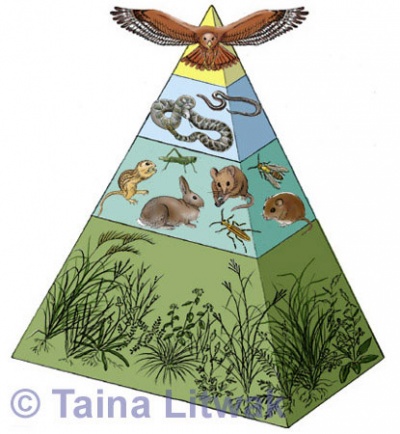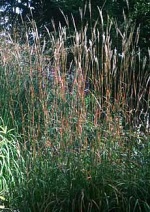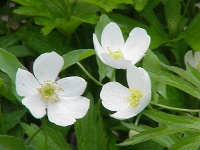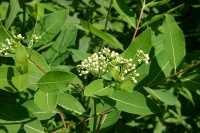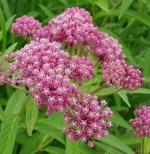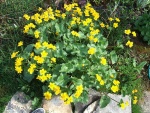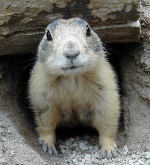Ecology/Grasslands
Grasslands is one of the biomes that is discussed in the Ecology event.
General Information
- Precipitation levels are too low to support trees but too great for deserts to form.
- Grasses are the major producer with several genera and species common but usually with one or two dominate.
- Most grasses possess rhizomes and are wind pollinated.
- Moderate temperature with notable extremes: -20° F to 110° F common, and even colder temperatures in the north.
- Variable precipitation: 6-40 in (15-100 cm).
- Scattered rain and lightening common in summer months ("convection storms") with more general rains and snows in winter months.
- Soils generally fertile, deep and rich; variable
- Growing season of 120-200 days.
- Generally flat to rolling topography cut by stream drainages where there is a river-bank habitat.
- Fire a major factor in maintaining biome.
- Dominated by grazing animals (deer, antelope, buffalo - once common but now rarely native to the range), burrowing small animals, and song birds.
Where and What They Are
Grasslands comprise most of the central United States (see map).
Tall-grass prairies in the east are nearest to Eastern Deciduous Forests. The grasses are tall (3-4 ft or 1-1.5 m tall) with deep roots. 24-40 in (65-100 cm)precipitation annually.
Mid-grass prairies are in the central area. The grasses are to 4 ft (1.5 m) tall. 14-25 in (35-65 cm) precipitation annually.
Short-grass prairies are in the west. This type of prairie covers the most land of any kind of prairie in North America. It is near the deserts of western US. There are short grasses (less than 20 in or 50 cm tall). About 10 in precipitation annually.
Food Consumption
Here is an example of a grassland food pyramid:
Adaptations in types of Grassland Organisms
Plants
- Herbs and legumes (nitrogen fixing) among the grasses
- Many plants possess rhizomes (underground stems) and are wind pollinated
- Soils generally fertile, deep and rich in nutrients (Bread baskets of the world)
- Native plants are perennials while crop grains are annuals
- Grasses have three strata – roots, growth at ground level, and taller foliage
- Half of growth may be below ground
- Grazed taller foliage will grow back
- Taller foliage above ground adapted to withstand strong winds, fires, extreme temperature changes
Animals
- Herds (safety in numbers)
- Burrowing small animals (colonies as prairie dogs)
- Flight song birds – strong fliers
- Long distance vision for predator & prey
- Eyes of grazing animals well above snout
- Many are built for speed – live in herds or colonies
- Small creatures can stand on haunches
- Some hop up and down or hop long distances
- Camouflage coloration
- Underground burrows
- Birds – strong fliers (strong winds), flight song birds to attract mates in air, nest in tall grass
Species and their Places in the Trophic Pyramid
Producers
Allium canadense
Allium canadense (known as Wild Onion and Meadow Garlic) is is a perennial plant native to North America.
- It has an edible bulb covered with a dense skin of brown fibers and tastes like an onion. The plant also has strong, onion-like odor.
- The narrow, grass-like leaves originate near the base of the stem, which is topped by a dome-like cluster of star-shaped, pink or white flowers.
- It typically flowers in the spring and early summer, from May to June.
- Though the plant is edible, it pays to be careful in identifying it as there are several look-a-likes.
- The juice of the plant is used as a moth repellent, and the whole plant is said to repel insects and moles. The plant can be rubbed on exposed parts of the body to protect them from the bites of scorpions and lizards.
Andropogon gerardii
Andropogon gerardii (known as Big Bluestem) is a tall grass native to much of the prairie and Great Plains regions of North America.
- Big Bluestem is tolerant of a wide range of soils and moisture.
- Depending on soil and moisture conditions, it grows to a height of 1 – 3m (3 – 10 ft).
- Big Bluestem is a perennial grass.
- The stem base turns to a blue-purple as it matures.
- The seed heads have three spike-like projections, resulting in another common name for big bluestem — "turkey foot."
- The roots are deep, and the plants send out strong, tough rhizomes, so it forms very strong sod.
- Big bluestem is also called tallgrass or simply called prairie tallgrass.
- Big bluestem is a late-successional grass in prairie ecosystems.
- It grows in tall, dense stands that shade out other plant species. These stands tend to gradually increase in size over time, unless a disturbance (such as fire) allows other plant species to re-establish themselves.
- Bluestem, which has many variants, is considered to be good forage for horses and cattle, and can also be cut and used for hay.
- It has a high protein level.
- While not considered the highest quality native forage found in the United States, it has long been considered a desirable and ecologically important grass by cattle ranchers and range-land ecologists.
- Bluestem grass is also used by landscapers and home owners who want to create a 'native' look in their lawns and gardens.
- Due to its high biomass, big bluestem is being considered as a potential feedstock for ethanol production.
Anemone canadensis
Anemone canadensis (known as Canada Anemone, Round-headed Anemone or Crowfoot) is a spring to early summer flowering plant that can sometimes be found flowering till late summer in the genus Anemone and family Ranunculaceae.
- It is native to the eastern half of northern North America.
- It is sometimes grown in gardens for its attractive bright white flowers.
- Plants grow 20-80 cm tall from ascending caudices formed on long running rhizomes, the rhizomes ascending to horizontal, somewhat fleshy in texture and golden-brown in color.
- Basal leaves are simple and deeply divided with 1 to 5 produced per caudice.
- The leaf petioles 8-22(-37) cm long. Leaf blades orbiculate in shape and 4-10 cm wide and 5-15(-20) cm long.
- The leaves have sagittate to nearly truncate shaped bases and serrated margins.
- The leaf surfaces are covered with short, soft hairs (puberulous), with the undersides more densely covered.
- Each leaf normally has 3 segments that are lanceolate to oblanceolate in shape.
- Inflorescences with 1 to 3+ flowers, rarely grouped into cymes.
- The stem holding the flowers called peduncles with hairs puberulous to villous.
- The flowers with 3 stemless involucral bracts, sometimes having secondary involucres with 2 bracts, remotely subtending the flowers.
- The bracts simple, more or less similar in shape to the basal leaves, being broadly obtriangular and 3-cleft and 3-10 cm wide.
- The bases of the bracts are broadly cuneate in shape and fused together with margins sharply but irregularly serrated and incised with acuminate tips, surfaces puberulous, more so underneath; segments 3, lanceolate to oblanceolate; lateral segments unlobed or 1×-lobed; ultimate lobes (8-)10-15(-20) mm long.
- The bright white colored flowers are composed of 5 sepals normally, that are obovate in shape, each (8-)10-20(-25) mm long and 5-15 mm wide, hairy or hairless.
- The flowers have 80-100 stamens placed in the middle of the sepals.
- After blooming fruits are produced in spheric to ovoid shaped heads of achenes that are green in color, the pedicel or stem holding the cluster of seeds (fruits) is 7.5-11.5 cm long.
- Each achene is obovoid to ellipsoid in shape, (2.5-)3-6 long and 3.5-6 mm wide, with winged margins, and has a straight beak 2-6 mm long.
- This species of anemone is found growing in meadows, along roadsides, and in low shrubby areas where the soil is moisture retentive
- It can spread by way of underground running rhizomes to form large thick colonies or spread-out along shorelines in long rows.
- When growing amongst thick vegetation, plants are sparsely flowering.
- Anemone canadensis is distinguishable from others in the genus by its sessile (stalkless) 5-7 lobed leaves which surround the stem.
- The main range is throughout Southern Canada to Missouri, Illinois, western Virginia and northern New Jersey, although it can be found as far West as British Columbia and as far South as New Mexico.
- In former times it was used medically by North American indigenous peoples as an astringent and as a styptic for wounds, sores, and nosebleeds, and as an eyewash.
- It is likely that most Anemones contain the caustic irritants of the Ranunculaceae family.
Apocynum cannabinum
Apocynum cannabinum (known as Dogbane, Amy Root, Hemp Dogbane, Rheumatism Root, or Wild Cotton) is a perennial herbaceous plant that grows throughout much of North America, in the southern half of Canada and throughout the United States.
- It grows up to 2 meters tall.
- It prefers moist places.
- It is a poisonous plant; the name means "poisonous to dogs".
- All parts of the plant are poisonous and can cause cardiac arrest if ingested.
- The stems are reddish and contain a milky latex capable of causing skin blisters.
- The leaves are opposite, simple broad lanceolate, 7-15 cm long and 3-5 cm broad, entire, and smooth on top with white hairs on the underside.
- The flowers are produced in mid summer, with large sepals, and a five-lobed white corolla.
- It grows in open wooded areas, ditches, and hillsides; in gardens it can be invasive, growing from spreading roots.
- When growing among corn, Apocynum cannabinum can reduce yields by up to 10% and when growing among soybeans, by up to 40%.
- It can be controlled through mechanical means, although it is difficult to control with herbicides.
- Canadian hemp was used as a source of fiber by Native Americans, to make hunting nets, fishing lines, clothing, and twine.
- It was also used in herbal medicine to treat syphilis, rheumatism, intestinal worms, fever, asthma, and dysentery.
- Although the toxins from the plant can cause nausea and catharsis, it has also been used for slowing the pulse.
Asclepias incarnata
Asclepias incarnata (known as Swamp Milkweed, Rose Milkweed, Swamp Silkweed, or White Indian Hemp) is a herbaceous, perennial plant species native to North America.
- It is found growing in damp to wet soils and also is cultivated as a garden plant for its attractive flowers, which are visited by butterflies and other pollinators due to its copious production of nectar.
- Like most other milkweeds, it has sap containing toxic chemicals, a characteristic that repels insects and herbivorous animals.
- Swamp milkweed is an upright, 100- to 150-centimeter (39- to 59-inches) tall plant, growing from thick, fleshy, white roots.
- Typically, its stems are branched and the clump forming plants emerge in late spring after most other plants have begun growth for the year.
- The oppositely arranged leaves are 7 to 15 centimeters (2.75 to 6 inches) long and are narrow and lance-shaped, with the ends tapering to a sharp point.
- The plants bloom in early to mid-summer, producing small, fragrant, pink to mauve (sometimes white) colored flowers in rounded umbels.
- The flower color may vary from darker shades of purple to soft, pinkish purple and a white flowering form exists as well.
- The flowers have five reflexed petals and an elevated central crown.
- After blooming, green seed pods, approximately 12 centimeters (4.5 inches) long, are produced that when ripe, split open.
- They then release light to dark brown, flat seeds that are attached to silver-white silky-hairs ideal for catching the wind.
- This natural mechanism for seed dispersal is similar to that used by other milkweed plants.
- Swamp milkweed prefers moisture retentive to damp soils in full sun to partial shade and typically, is found growing wild near the edges of ponds, lakes, streams, and low areas—or along ditches.
- It is one of the best attractors of the Monarch Butterfly, which feeds on the flowers and lays her eggs on the plants. The emerging caterpillars then feed on the leaves.
- The plants have specialized roots for living in heavy wet soils.
- The scented, thick, white roots are adapted to live in environments low in oxygen.
- Blooming occurs in mid to late summer and after blooming; long, relatively thin, rounded pods are produced that grow uprightly.
- The pods split open in late summer to late fall, releasing seeds that are attached to silky hairs, which act as parachutes that carry the seeds on the currents of the wind.
- This species is cultivated frequently and a number of cultivars are available.
- They are used especially in gardens designed to attract butterflies.
- The nectar of the plant attracts many other species of butterflies and insects as well.
- The plants are also sold as freshly cut flowers, mostly for their long-lasting flower display, but sometimes, for the distinctive seed pods.
Asclepias syriaca
Asclepias syriaca (known as Common Milkweed, Butterfly flower, Silkweed, Silky Swallow-wort, or Virginia Silkweed) is a herbaceous plant species. It is in the genus Asclepias, making it a type of milkweed.
- This species is native to most of North America east of the Rocky Mountains, excluding the drier parts of the Prairies.
- It grows in sandy soils and appreciates lots of sunlight.
- It was one of the earliest North American species described in Cornut's 1635 Canadensium plantarum historia.
- The specific epithet was reused by Linnaeus due to Cornut's confusion with a species from Asia Minor.
- Common milkweed is a herbaceous perennial plant growing to 1-2 m tall from a rhizome.
- The stem and all parts of the plants produce a white latex when broken.
- The leaves are opposite, simple broad ovate-lanceolate, 7-25 cm long and 3-12 cm broad, usually with an undulate margin and a red-colored main vein.
- They have a very short petiole and a velvety underside.
- The flowers are grouped in several spherical umbels with numerous flowers in each umbel.
- The individual flowers are small, 1-2 cm diameter, perfumed, with five cornate hoods.
- The seeds are attached to long, white flossy hairs and encased in large follicles.
Calamagrostis canadensis
Calamagrostis canadensis (known as Bluejoint or Canadian Redgrass) is a species of grass native to most of northern North America, including most all of Canada and all of the continental United States except for the South.
- It is a perennial grass with a branching stem reaching heights between 60 centimeters and 1.5 meters.
- The flat, drooping leaves are rough with tiny hairs.
- The inflorescence is up to 25 centimeters long and may be open and loose or narrow and densely packed with spikelets.
- Each spikelet is about half a centimeter long and purplish in color.
- It is a palatable food plant for livestock and wild grazing animals.
- It is a tough rhizomatous grass that provides soil stability in wet areas and is one of the first plants to reestablish on sites of recent oil spills.
- It can be a nuisance on sites of forest revegetation because it can outcompete conifer seedlings.
Caltha palustris
Caltha palustris (known as Marsh Marigold or Kingcup) belongs to the Ranunculaceae (buttercup family). It is native to temperate regions of the Northern Hemisphere (Europe including Iceland and Arctic Russia, temperate and Arctic Asia, and North America).
- It grows in wet, boggy places, such as marshes, fens, ditches and wet woods.
- It becomes most luxuriant in partial shade, but is rare on peat.
- In the UK, it is probably one of the most ancient British native plants, surviving the glaciations and flourishing after the last retreat of the ice, in a landscape inundated with glacial meltwaters.
- The plant is a herbaceous perennial growing to 80 cm tall.
- The leaves are rounded to kidney-shaped, 3-20 cm across, with a bluntly serrated margin and a thick, waxy texture.
- Stems are hollow.
- The flowers are yellow, 2-5 cm diameter, with 4-9 (mostly 5) petaloid sepals and many yellow stamens; they are borne in early spring to late summer.
- The flowers are visited by a great variety of insects for pollen and for the nectar secreted from small depressions, one on each side of each carpel.
- Carpels form into green sac-like follicles to 1 cm long, each opening to release several seeds.
- It flowers early April and May and is very valuable to insects at this time as they provide nectar and pollen to them.
1st Level Consumers
Cynomys gunnisoni
Cynomys gunnisoni (known as Gunnison's Prairie Dog) is one of five species of the Prairie Dog. Predominantly related to the North American and Eurasian ground squirrels, this species belongs to the squirrel family of rodents.
- Gunnison’s Prairie Dogs are primarily distributed in the four corners of North America: the region where Utah, Colorado, New Mexico, and Arizona meet.
- Gunnison’s Prairie Dogs possess a body that is stout with a very short tail that measures 1.25 to 2.25 inches (3 to 6 centimeters).
- Their overall size differs anywhere from around 12 to 14 inches (30 to 37 centimeters).
- However, on average males are usually larger in size than females.
- This breed weighs from a range of 1.5 to 2.5 lbs (0.5 to 1 kg).
- A Gunnison's prairie dog skull holds 22 teeth. The animals have 5 pairs of mammary glands.



